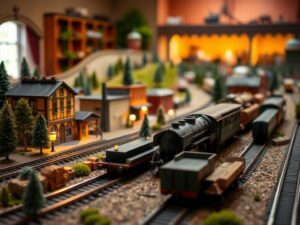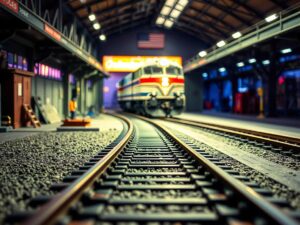How to Set Up DCC Sound Decoders for Realism
How to Set Up DCC Sound Decoders for Realism
How to Set Up DCC Sound Decoders for Realism – Level Up Your HO Scale RailWorld!
Hey there fellow railfans! ð Welcome back to the blog. Today, we’re diving deep into the world of DCC sound decoder setup â because let’s be honest, a truly immersive model railroad experience needs more than just visual splendor. We want to hear those rumbling engines, the clickety-clack of wheels on track, and maybe even a satisfying “WHOOSH” as our freight trains speed past.
If you’re new to this exciting realm of hobby soundscapes, think of DCC sound decoders as tiny computers embedded within your model locomotives. They interpret digital commands from your DCC controller and then â hereâs the magic part â produce incredibly realistic sound effects synchronized with your train’s movements.
But how do we get this audio wonder working? Don’t worry, it’s easier than you think! Let’s break down the process step-by-step, from selecting the right decoder to fine-tuning those sound effects.
1. Choosing Your DCC Sound Decoder:
It’s like picking the right voice for your locomotive! There are many reputable brands out there (e.g., ESU LokSound, Digitrax Zephyr, QSI), each with varying features and levels of complexity.
- Beginner-friendly decoders often come pre-programmed with basic sounds and a simple configuration process.
- Advanced decoders offer incredible detail â multiple sound profiles for different locomotives (think steam vs diesel!), custom programming options, and even speaker integration for more powerful audio output.
A few things to consider when making your choice:
- Type of Locomotive: Different types of trains (steam, diesel, electric) have distinct sound profiles. Ensure the decoder you choose has sounds appropriate for your model.
- Size: Decoders come in different sizes to fit various locomotives. Measure carefully to ensure a snug fit.
- Features: Think about whatâs important to you: pre-recorded sounds, customizable functions, speaker support, and so on.
2. Installing Your DCC Sound Decoder: A Quick How-To Guide
Once you’ve found your perfect sound decoder, installation is often straightforward, even for newcomers. It involves soldering electrical connections between the decoderâs components (usually a printed circuit board with small terminals) and your locomotive’s existing wiring harness.
Important Tip: Work in a well-lit area with proper tools like solder irons and helping hands. Be patient, take your time, and if you feel uncertain about any steps, seek advice from an experienced model railroader or consult the manufacturer’s installation instructions for your specific decoder.
3. Connecting to Your DCC System:
With your sound decoder installed and secured, it’s time to plug into your digital command control (DCC) system! Typically, this involves connecting a cable with two wires from the decoder to the rails or a booster module within your layout.
This connection sends electrical signals (the DCC language) that control the locomotive’s movements, lighting, and of course, the amazing sounds emanating from the decoder.
4. Sound Configuration & Customization:
Now for the truly exciting part â tailoring those sounds to create an immersive rail experience! Many sound decoders come with their own dedicated programming software, often accessible via a computer or laptop connected to your DCC system.
Using this software, you can:
- Select different sound profiles: Change between realistic variations for various locomotives (steam vs diesel), speed ranges, even weather effects!
-
Adjust volume levels: Fine-tune the balance of engine sounds, horn blasts, bell chimes, and other environmental noises.
-
Program function keys: Map DCC buttons to trigger unique sounds, like air brakes or reversing horns â adding an extra layer of control and realism.
- Customize sound curves: Determine how engine pitch and intensity change based on locomotive speed for even more dynamic audio output.
5. Tips & Tricks from a Seasoned Railfan:
Alright, you’re ready to rock and roll! But before you embark on your sound-infused railway journey, here are some extra insights gleaned from years of tinkering with DCC decoders:
- Start Simple: If youâre new to this, begin with a pre-programmed decoder. Familiarize yourself with the basics, then explore advanced customization as you gain confidence.
- Use Reference Materials: Sound recordings of real locomotives are invaluable! Compare those sounds with your decoder outputs to ensure authenticity.
- Patience is Key: DCC sound decoder setup can take time, especially for intricate customizations. Don’t get discouraged â take breaks and revisit challenges later with a fresh perspective.
Letâs Build an Immersive Sound World Together
Remember, friends, model railroading isnât just about visual displays; itâs about crafting a sensory experience. Adding realistic sound effects transforms your layout from static scenery into a dynamic world brimming with life.
Share your experiences! Have any questions or tips of your own to add? Post them below in the comments section and let’s continue this fascinating journey together! Happy Railfanning!




